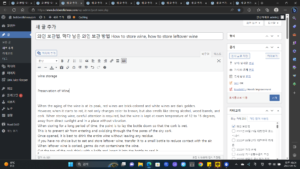wine storage
Preservation of Wine
와인 보관법
When the aging of the wine is at its peak, red wines are brick-colored and white wines are dark golden.
However, when it starts to rot, it not only changes color to brown, but also smells like strong alcohol, wood barrels, and cork. When storing wine, careful attention is required, but the wine is kept at room temperature of 12 to 15 degrees, away from direct sunlight and in a place without vibration.
When storing for a long period of time, the point is to lay the bottle down so that the cork is wet.
This is to prevent air from entering and oxidizing through the fine pores of the dry cork.
Once opened, it is best to drink the entire wine without leaving any residue.
If you have no choice but to eat and store leftover wine, transfer it to a small bottle to reduce contact with the air.
When leftover wine is corked, germs do not contaminate the wine.
Cut the top of the cork thinly with a knife and insert it into the bottle to seal it.
White wine won’t go bad if kept in the refrigerator for several days, but expensive red wine should not be stored for more than a day after uncorking.
How to store red wine
Store wine bottles lying flat:
It should be stored in a place that is not exposed to direct sunlight and heat.
If you leave it standing upright for a long time, the cork will dry out and air will penetrate through the gap, oxidizing the wine.
Store at ideal temperatures:
the ideal temperature is
It is between 13°C and 18°C.
There should be no significant temperature changes.
It is important to maintain an appropriate temperature because a severe change in temperature shortens the lifespan much more than a high or low temperature.
– Sparkling wine: 6 to 10 degrees
– Sweet wine: 6-8 degrees
– Light bodied white wine: 7 to 10 degrees
-Heavy-bodied white wine: 10-13 degrees
– Light bodied red wine: 13 degrees
-Heavy-bodied red wine: Room temperature (15-18 degrees)
Store away from strong sunlight, including sunlight.
Store in a place free from severe vibration.
Once opened, wine should be consumed within a few days.
Red wine that has been in contact with air once can oxidize and go bad, so the wine that has been opened must be re-corked.
Basic principles of storing leftover wine
Keep wine refrigerated:
Since yeast ferments the remaining glucose in fermentation, most of the fermentation activity takes place at room temperature. Therefore, by storing the leftover wine at a lower temperature, the chemical class can be reduced as much as possible.
Therefore, when storing leftover wine, it is best to keep it in a place that maintains a constant low temperature by storing it in the innermost part of a refrigerator or in a place such as a kimchi refrigerator rather than in a compartment that can be seen immediately after opening the door or in a beverage compartment.
Minimize contact between wine and oxygen:
When wine encounters oxygen, oxidation occurs and the taste begins to change. Therefore, it is important to minimize the contact with oxygen, which is the condition for oxidation, to prevent oxidation.
Therefore, it is important to store it upright in a bottle with a narrow neck rather than a container that can reach oxygen well. This should minimize this contact with oxygen.
How to store leftover wine
Reusable corks and wine stoppers:
In this wine storage method, the corco stopper originally used for wine is put back into the opening to prevent contact with air, or the wine stopper is used to close the opening.
Since the wine is not usually capped but corked, it is put back in to minimize contact with the air.
However, this is a stopgap measure as it does not provide maximum air containment.
It is recommended to use the remaining wine within 2-3 days. For a long time, there is a high probability that the wine will oxidize and the taste will change.
Wine vacuum pump stopper:
The second wine storage method, the wine vacuum pump stopper, as the name suggests, is a device that can store wine in a vacuum form. Generally, it is used by inserting it into the entrance of wine like a wine stopper, and it holds the wine in a vacuum form, so it can minimize contact with air.
The price of a vacuum pump stopper is higher than that of a stopper, but the effect of vacuum minimizes contact with air, so you can keep and drink wine for a longer time.
Storage using plastic bottles:
The last wine storage method, storage using plastic bottles, is a method used when there is no stopper or pump stopper at home, but you want to store wine in the form of vacuum as much as possible.
First, pour the wine into a well-washed plastic bottle. Then, squeeze the plastic bottle so that the wine fills up to the mouth of the bottle.
It is to reduce the air inside the plastic bottle as much as possible by crushing the plastic bottle. After crushing the plastic bottle enough to overflow, close the plastic bottle mouth and store it.
In this case, there is minimal air in the plastic bottle, so oxidation of the remaining wine is minimized. How to store wine Since a plastic bottle is a plastic bottle, it is easy to store in the refrigerator. If you store it like this, you can drink wine after 7 to 10 days without a big change in taste.